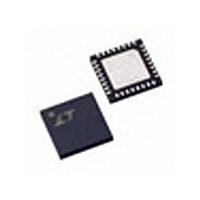LTC3770EUH#TR Linear Technology, LTC3770EUH#TR Datasheet - Page 19

LTC3770EUH#TR
Manufacturer Part Number
LTC3770EUH#TR
Description
Manufacturer
Linear Technology
Datasheet
1.LTC3770EUHTR.pdf
(24 pages)
Specifications of LTC3770EUH#TR
Lead Free Status / RoHS Status
Not Compliant
Available stocks
Company
Part Number
Manufacturer
Quantity
Price
APPLICATIONS INFORMATION
oscillators are identical. At this stable operating point the
phase comparator output is open and the fi lter capacitor
C
driven from a low impedance source such as a logic gate
located close to the pin.
The loop fi lter components (C
current pulses from the phase detector and provide a
stable input to the voltage controlled oscillator. The fi lter
components C
acquires lock. Typically R
0.1μF.
Dead Time Control
To further optimize the effi ciency, the LTC3770 gives us-
ers some control over the dead time of the Top gate low
and Bottom gate high transition. By applying a DC voltage
on the Z0 pin, the TG low BG high dead time can be pro-
grammed. Because the dead time is a strong function of
the load current and the type of MOSFET used, users need
to be careful to optimize the dead time for their particular
applications. Figure 11 shows the relation between the TG
Low BG High Dead time by varying the Z0 voltages. For
an application using LTC3770 with load current of 5A and
IR7811W MOSFETs, the dead time could be optimized. To
make sure that there is no shoot-through under all condi-
tions, a dead time of 70ns is selected. This corresponds to
a DC voltage about 2.6V on Z0 pin. This voltage can easily
be generated with a resistor divider off INTV
LP
holds the voltage. The LTC3770 PLLIN pin must be
Figure 11. TG Low BG High Dead Time vs Z0 Voltage
180
–20
160
140
120
100
80
60
40
20
0
LP
0
I
IR7811W FETs
OUT
and R
= 5A
1
LP
Z0 VOLTAGE (V)
LP
2
determine how fast the loop
=10kΩ and C
LP
3
, R
LP
) smooth out the
4
3770 F11
LP
CC
is 0.01μF to
5
.
Effi ciency Considerations
The percent effi ciency of a switching regulator is equal to
the output power divided by the input power times 100%.
It is often useful to analyze individual losses to determine
what is limiting the effi ciency and which change would
produce the most improvement. Although all dissipative
elements in the circuit produce losses, four main sources
account for most of the losses in LTC3770 circuits:
1. DC I
MOSFETs, inductor and PC board traces and cause the
effi ciency to drop at high output currents. In continuous
mode the average output current fl ows through L, but is
chopped between the top and bottom MOSFETs. If the two
MOSFETs have approximately the same R
resistance of one MOSFET can simply be summed with
the resistances of L and the board traces to obtain the
DC I
0.005Ω, the loss will range from 15mW to 1.5W as the
output current varies from 1A to 10A.
2. Transition loss. This loss arises from the brief amount
of time the top MOSFET spends in the saturated region
during switch node transitions. It depends upon the
input voltage, load current, driver strength and MOSFET
capacitance, among other factors. The loss is signifi cant
at input voltages above 20V and can be estimated from:
3. INTV
and control currents.
4. C
fi ltering the large RMS input current to the regulator. It
must have a very low ESR to minimize the AC I
suffi cient capacitance to prevent the RMS current from
causing additional upstream losses in fuses or batteries.
Other losses, including C
conduction loss during dead time and inductor core loss
generally account for less than 2% additional loss.
When making adjustments to improve effi ciency, the
input current is the best indicator of changes in effi ciency.
Transition Loss ≅ (1.7A
IN
2
R loss. For example, if R
loss. The input capacitor has the diffi cult job of
2
CC
R losses. These arise from the resistances of the
current. This is the sum of the MOSFET driver
OUT
–1
) V
ESR loss, Schottky diode D1
DS(ON)
IN
2
I
OUT
= 0.01Ω and R
LTC3770
C
RSS
DS(ON)
f
2
R loss and
, then the
19
3770fc
L
=













